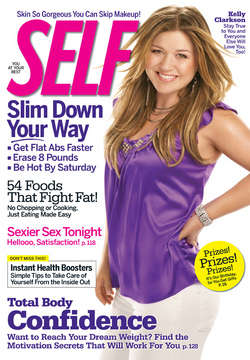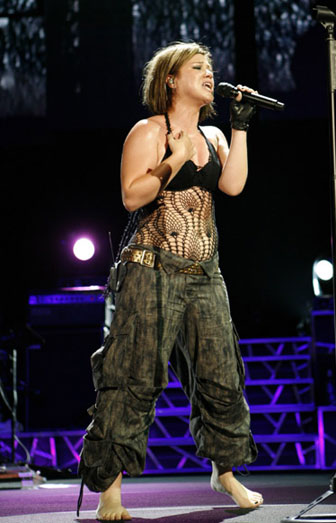Laurie and Debbie say:
Cross Blogged on Body Impolitic
Self Magazine isn’t ashamed that they clipped pieces off of Kelly Clarkson’s body for their current cover. They’re proud of it. Lucy Danziger, editor-in-chief at Self, did a whole blog on the Self site about the decision to photoshop Clarkson’s figure.

Here’s a picture of Clarkson as she’s been looking recently, without photo manipulation. Note how her clothing choices reflect comfort in her body.

Danziger explains their decision:
Did we alter her appearance? Only to make her look her personal best. Did we publish an act of fiction? No. Not unless you think all photos are that. But in the sense that Kelly is the picture of confidence, and she truly is, then I think this photo is the truest we have ever put out there on the newsstand. I love her spirit and her music and her personality that comes through in our interview in SELF. She is happy in her own skin, and she is confident in her music, her writing, her singing, her performing. That is what we all relate to. Whether she is up or down in pounds is irrelevant (and to set the record straight, she works out and does boot-camp-style training, so she is as fit as anyone else we have featured in SELF). Kelly says she doesn’t care what people think of her weight. So we say: That is the role model for the rest of us.
This is absolutely classic. Clarkson is confident and doesn’t care what people think. We just wanted to make her look her best. So we trimmed off some pounds Clarkson is fine with showing. By doing that, we once again perpetuated a lie about how women really look. This adds to the burden that every woman who looks at this cover carries.
“No matter how much I diet, I never look like the women in the magazines.”
“My boyfriend says I’m too fat. We were in the supermarket the other day, and he was pointing out women on magazine covers whose hips and waist are slimmer than mine.”
“I give up; I’ll just stop eating and maybe then I’ll look like Kelly Clarkson.”
But Danziger isn’t done. She waxes elegant about some casual shots of Clarkson with her sister (but doesn’t reproduce them in her blog). She says:
Frankly, those are my favorite pictures, the ones that are snappy happy. My husband has given me an appreciation for the beauty of a snapshot. But that isn’t a cover. A cover’s job is to sell the magazine, and we do that, every month, thanks to our readers. So thank you.
Your job: Think about your photographs and what you want them to convey. And go ahead and be confident in every shot, in every moment. Because the truest beauty is the kind that comes from within.
By the way, she also tries to claim that photoshopping off that weight is no different than make-up, or hairstyling. Here’s what’s different: if you’re there on the shoot, you would see the make-up and hairstyle as they were finished, but you’d also see Clarkson’s actual body.
We agree with Margaret at Jezebel:
Danziger is is right: Kelly Clarkson is a “great role model for women of all sizes.” When the press goes after celebrities for gaining weight many apologize to the public, like Oprah Winfrey or Kirstie Alley, or frantically exercise and appear on the cover of Us flaunting their slimmed down selves like Jennifer Love Hewitt. So far Clarkson has only declared that she’s OK with her body and backed her statements up by performing in clothing that exposes her figure, rather than hiding under billowy outfits.
So here’s our advice to Susan Danziger and Self:
“A cover’s job is to sell the magazine, which can be done without lying to your readers.”
“Your job: Think about your photographs and what you want them to convey. And go ahead and believe Kelly Clarkson when she says she’s not tweaked about her weight. Because the truest beauty is the kind that you’re not ashamed to show on your magazine cover.”